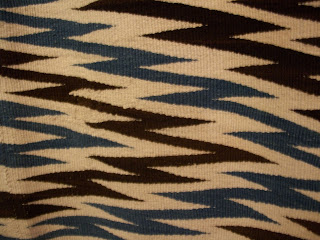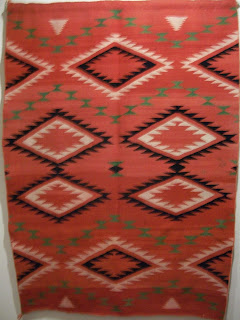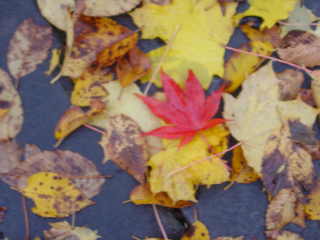 |
| This is ikat dyed from late 19th century. Little is known of the weaver, just that the link is Saltillo in nature. |
 |
| The close-up of the points--is this weft or warp ikat? |
 |
| Weft ikat==1800-1860; handspun cotton for warp, handspun brown, white, indigo for weft. |
 |
| Close-up of workmanship |
 |
| I especially took this photo to see how a patch was applied to cover up a hole. |
 |
| Just can't believe the sharpness of the points! |
 |
| Nice hatching and combining of colors |
 |
| This is pre-1860 Saltillo zig zag serape from Rio Grande Hispanic. The Tlaxcalan Indians of Saltillo, Mexico are credited with originating the Saltaillo serape serrated diamond pattern. Nineteenth century New Mexican weavings had fewer but larger design patterns and less intricaate background than the Saltillos from Northern Mexico. Horsemen used the serape because it was water tight and could eaisily be rolled up and carried behind the saddle when not in use. Like the Spanish cape, the serape was an accessory that represented status. |
 |
| Just nice sharp points! |
First Phase: developed in 1800, but tradition had been established around 1650. These blankets were made to be worn and had stripes that were woven with natural brown, white wools with indigo. The end of this phase was mostly used by Navajo, with a huge time of cultural change with Kit Carson's removal of their tribe in 1863 and their relocation to Fort Sumer, NM, where they were held captive until 1868. This led to their exposure to new materials and the Spanish American/Mexican patterns, which influenced their designs
 |
| This is a banded blanket, dated 1870-1890, Woven double width with natural handspun white and brown yarns. Handspun indigo and handspun aniline red. |
 |
| Moki striped blanket, 1880-1890, is a basic stripe pattern in natural brown or top dyed black and indigo broken by bands of white or red. This pattern wasd brought to the Southwest by the Spaniards and was used by Hispanic Pueblo and Navajo weavers. White Hispanic and Navajo weavers ventured far from the basic stripe. Pueblo weavers continued to weave it throughout the 19th century, using it as a background for more innovative geometric and serrate designs. So common was this design to the Hopi that the term MOKI, a name used by the Navajo for the Hopi, was applied to all blankets of this style despite the common to all three cultures. |
 |
| The small stripe added interest with the diverse twist. |
Second Phase: the stripes thinned out and triangluar forms were introduced. In addition new red dyes were incorporated and were strategically placed to accent significant points of the body. These forms began to imply the motifs that were to be installed in the third phase.
Third Phase: Stripes only functioned as a background and now diamonds and crosses appeared in the fore front. With the arrival of the railroad came the introduction of Germantown yarns and access to aniline dyes and with these materials came the "eye-dazzler" style
 |
| Fourth Phase Chief's blanket--woven entirely with handspun yarns in natural colors on churro wool. Now, you can see how progress involved in design and color placement |
 |
| This is more! Can you believe?! Stay tuned to another blog within the next few days with photos of more of these stunning blankets. |
























.JPG)



























